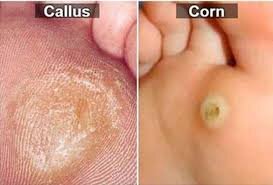Corns, Calluses and Cracks
Calluses, Corns and Cracks
“A rose by any other name smells as sweet.” A corn, callus or crack will hurt just as bad, no matter what you call it. Some other monikers for these painful lesions are fissures, seed corns, porokeratosis, hyperkeratosis. All of which are terms for hard skin. The differences lie in the location of the hard skin lesion, the direct cause and the best forms of treatment.
A Callus patch of hard skin that forms usually on the sole or sides of the foot. It is caused by friction. How does this friction occur? Likely ill fitting shoes, not wearing socks, a certain repetitive motion maybe from playing an instrument or certain sports. The repetitive rubbing causes friction, the friction triggers your body to build up an armor or hard skin. Unfortunately the body's plan of defense backfires because this hard patch of skin becomes further irritated in our shoes resulting in discomfort, sometimes even irritation and redness.
Corns are a cousin to the Callus. A corn or porokeratosis, also made of hardened skin is the result of direct pressure. Sometimes a curled toe, a misplaced seem in a shoe, bone that protrudes. A corn will have a hard center core, which accounts for another one of its names “seed corn”. The corn can appear to look like a small seed in the center of a larger callus.
Cracks or fissures occur most commonly on the heels. These cracks usually occur because of excessive dryness to the skin on the soles of your feet combined with pressure from walking. The heels absorb a lot of pressure when walking, it is the intense pressure with each step that causes the thickened dry brittle skin to crack open. Barefoot walking on hard surfaces can exacerbate these cracks, without shoes the heel will encounter more direct pressure. The cracks if not treated become painful and may even bleed.
While these issues alone are not dangerous- in persons with Diabetes, decreased sensation or Decreased blood flow to their feet; Callus, corns and cracks are a serious medical condition and should be treated by a Podiatrist and not at home.
Treatments
Removal of the hard dead skin can be done safely with a pumice stone or skin file.
Use specialty creams containing keratolytic agents to soften the skin aid in skin removal. These keratolytics, softens and dissolves the protein Keratin in the skin, which causes it to be hardened. Keratolytics can be found in creams, pads, liquids, as a foot mask or peels. Find my favorites here.
Soaking your foot in a warm water bath for 5-10 minutes prior to treatment will yield better results.
Using a foot moisturizer everyday is needed to prevent recurrence.
Checking shoes for proper fit, removing the irritating seam, wearing socks , house slippers or even a sandal at home on hard surfaces are all ways to treat the causes.
Identify a repetitive motion that may be causing irritation and avoid it.
If there is a foot deformity, see a doctor for recommendations on how to treat the curled toe or bunion.
Apply pads and cushions to areas of friction or pressure.
Never use a blade or razor to cut your skin at home. Using credo blades or other sharp devices often result in cuts to your health skin and may cause infection.
A podiatrist may cut away the hard skin with a blade, it is safe to be done by a doctor. Cutting away or debridement of a callus will not cause more callus to grow. Podiatrists are doctors who specialize in the foot and ankle, they are trained to assess the cause of these lesions, treat them and make recommendations on creams, shoes and lifestyle changes specific to you so that you can get the best results.
- Be well, Dr. D
Click below for products:




